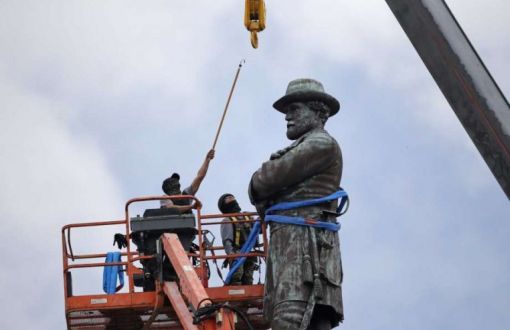Click to read the article in Turkish
On Saturday, August 12, the United States witnessed one of the most high-profile demonstrations by self-declared white supremacists in recent memory. Far-right activists travelled from around the country to gather in Charlottesville, Virginia for a “Unite the Right” march that was organized with the stated goal of protesting the removal of a Confederate statue. According to the organizers, it was also simultaneously designed to bring together various far-right groups who had previously failed to rally together due to ideological differences. In support of the rally, groups affiliated with older organizations like the Klu Klux Klan were present, just as members of newer white supremacist groups like Identity Evropa and Vanguard America also joined in. The neo-Nazi group National Socialist Movement was also reportedly present. Hearing about the rally, counterprotesters also gathered: some were local activists from the city, and around a hundred church and religious leaders also came to oppose the rally. Other counterprotester groups included the anti-racist group Black Lives Matter, as well as the anti-fascist group Antifa.
While both sides reportedly brought sticks, shields and chemical irritants to spray, a large number of the right-wing protesters were equipped with guns, including rifles. According to a reporter on the ground, among the counterprotesters there was also a small armed group called Redneck Revolt, but in comparison many more of the rally attendees were carrying weapons. On both Friday night before the rally and Saturday morning, violence broke out between rally supporters and counterprotesters. After several violent skirmishes, the police broke up the rally and cleared the park around noon. However, shortly thereafter, a woman was killed and 19 people were injured when a man drove his car into a group of counterprotesters. The driver had been seen marching and carrying the shield of the white supremacist group Vanguard America earlier that day.
Trump’s Charlottesville response
In response to these events, President Trump stated to the press that he condemned “in the strongest possible terms this egregious display of hatred, bigotry, and violence on many sides.” He was strongly rebuked for these comments across the political spectrum, with many Republicans also joining in to criticize his statement for failing to condemn the white supremacist violence at the rally, and for making it seem as though both groups were equally at fault for this violence. On Sunday, the White House released another statement, this time specifically calling out “white supremacists, KKK, neo-Nazi and all extremist groups,” but he appeared to go back on this comment once again during a press conference he gave on Monday, August 14. In response to reporters’ questions, he returned to his strategy of equivocation between the white supremacist groups attending the rally and the counterprotesters. He emphasized that the counterprotesters were “very, very violent” and that they “came charging with clubs in their hands.” He went on to state that not every person attending the rally was a “neo-Nazi” or “white supremacist” and that there were “very fine people on both sides.” These comments were once again criticized for the implication that white supremacists were “very fine people” and that “both sides” were responsible for the blame during protests in which one counterprotester was killed and 19 were injured.
Has Trump influenced the rising visibility of white supremacy in the US?
While Charlottesville was a deadly and violent manifestation of the increasing prominence of white supremacist politics in the US, according to the Southern Poverty Law Center, a legal organization that monitors hate groups, groups supporting white supremacist or neo-Nazi causes have generally been on the rise in the past few years. The SPLC notes several factors for this expansion, among them the election of Obama as the first black president in 2008. According to their research, white nationalist groups, the Klu Klux Klan, and neo-Nazi groups have all seen recent increases in chapter numbers, despite a slight reduction in official Klu Klux Klan chapters in the past year. The SLPC has emphasized that their statistics are most likely even underestimating the scope of white supremacist activities, since they do not take exact measure of the scope of internet organizing in their research, which has been key to the expansion and popularization of far-right ideas and groups in recent years.
What’s more, whereas the election of the first black president in the US may have propelled far-right extremists to organize during Obama’s presidency, the election of Trump seems to aided their cause to a greater degree, and groups explicitly supporting white supremacy, white nationalism and neo-Nazi causes have grown. Trump and these white supremacist groups seem to have a mutually reinforcing relationship: many white supremacists supported Trump’s election and his resulting presidency; in turn, Trump’s rhetoric and policies have encouraged white supremacist groups and have empowered them to organize more publically, with a prime example being the recent Charlottesville rally. In terms of support for Trump from such figures, the former Klu Klux Klan leader, David Duke, stated that he was “overjoyed to see Donald Trump and most Americans embrace most of the issues that I’ve championed for years.” According to SLPC editor Mark Potok, many of the newer white supremacist groups such as Vanguard America and Identity Evropa seem to have been directly inspired by Trump’s campaign and election. One prominent far-right figure, Richard Spencer, gave a speech directly after Trump’s election in which he concluded with the phrase “Hail Trump, hail our people, hail victory!”; this was followed by many attendees giving the Nazi salute.
Meanwhile, Trump’s rhetoric has supported far-right and racist ideologies, as seen for example in his demonization of Mexican immigrants as “rapists” and his re-tweeting of white supremacist accounts on Twitter. More importantly, his appointment of advisors associated with racist policies and white nationalist media like Jeff Sessions and Steve Bannon, respectively, and his policies, such as the Muslim ban and his stated plan of building a wall at the US-Mexican border, have in turn supported and helped to normalize this type of anti-Muslim, xenophobic politics.
However, even with this synergistic effect between Trump and the far-right, the US has also seen significant resistance emerge against white supremacist movements. Since August 12, several cities, among them Baltimore and New Orleans, have removed Confederate statues in public areas. Last weekend in Boston, a conservative rally saw a low turnout of less than a hundred participants, which was dwarfed by tens of thousands of participants in a counter-rally. After CEOs started resigning from two of the president’s main business councils in protest of his response to Charlottesville, Trump was forced to preemptively dissolve them. And despite reports that his departure was unrelated to the events in Charlottesville, one of Trump’s advisors most associated with the far right, Steve Bannon, stepped down from his position as a White House chief strategist on August 18. While the past year has shown us that white supremacist groups have gained more prominence in recent years and under Trump’s presidency especially, they have not done so without fierce criticism. If recent events give any indication, further public activity by white supremacist groups will be continue to be followed by backlash and concomitant resistance as well. (LN/BG/TK)
Translation: Bengi Güven





